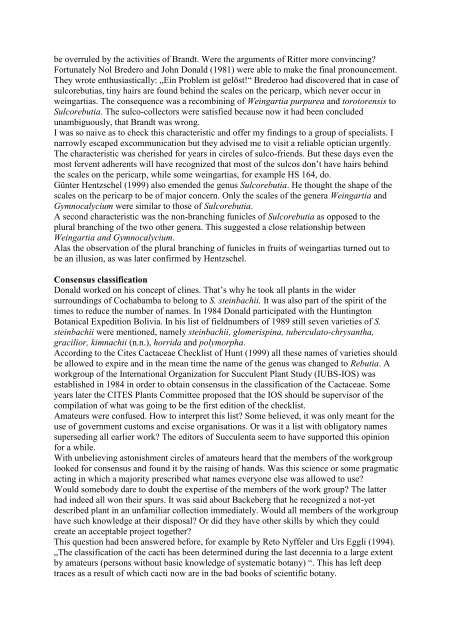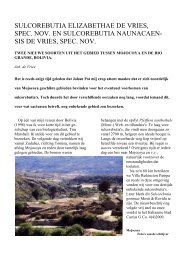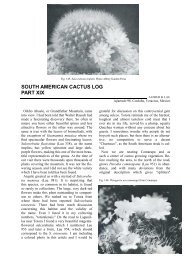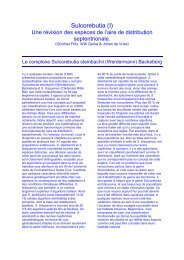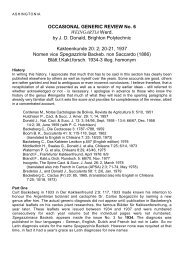Sulcorebutia, food for taxonomists?
Sulcorebutia, food for taxonomists?
Sulcorebutia, food for taxonomists?
You also want an ePaper? Increase the reach of your titles
YUMPU automatically turns print PDFs into web optimized ePapers that Google loves.
e overruled by the activities of Brandt. Were the arguments of Ritter more convincing?<br />
Fortunately Nol Bredero and John Donald (1981) were able to make the final pronouncement.<br />
They wrote enthusiastically: „Ein Problem ist gelöst!“ Brederoo had discovered that in case of<br />
sulcorebutias, tiny hairs are found behind the scales on the pericarp, which never occur in<br />
weingartias. The consequence was a recombining of Weingartia purpurea and torotorensis to<br />
<strong>Sulcorebutia</strong>. The sulco-collectors were satisfied because now it had been concluded<br />
unambiguously, that Brandt was wrong.<br />
I was so naive as to check this characteristic and offer my findings to a group of specialists. I<br />
narrowly escaped excommunication but they advised me to visit a reliable optician urgently.<br />
The characteristic was cherished <strong>for</strong> years in circles of sulco-friends. But these days even the<br />
most fervent adherents will have recognized that most of the sulcos don’t have hairs behind<br />
the scales on the pericarp, while some weingartias, <strong>for</strong> example HS 164, do.<br />
Günter Hentzschel (1999) also emended the genus <strong>Sulcorebutia</strong>. He thought the shape of the<br />
scales on the pericarp to be of major concern. Only the scales of the genera Weingartia and<br />
Gymnocalycium were similar to those of <strong>Sulcorebutia</strong>.<br />
A second characteristic was the non-branching funicles of <strong>Sulcorebutia</strong> as opposed to the<br />
plural branching of the two other genera. This suggested a close relationship between<br />
Weingartia and Gymnocalycium.<br />
Alas the observation of the plural branching of funicles in fruits of weingartias turned out to<br />
be an illusion, as was later confirmed by Hentzschel.<br />
Consensus classification<br />
Donald worked on his concept of clines. That’s why he took all plants in the wider<br />
surroundings of Cochabamba to belong to S. steinbachii. It was also part of the spirit of the<br />
times to reduce the number of names. In 1984 Donald participated with the Huntington<br />
Botanical Expedition Bolivia. In his list of fieldnumbers of 1989 still seven varieties of S.<br />
steinbachii were mentioned, namely steinbachii, glomerispina, tuberculato-chrysantha,<br />
gracilior, kimnachii (n.n.), horrida and polymorpha.<br />
According to the Cites Cactaceae Checklist of Hunt (1999) all these names of varieties should<br />
be allowed to expire and in the mean time the name of the genus was changed to Rebutia. A<br />
workgroup of the International Organization <strong>for</strong> Succulent Plant Study (IUBS-IOS) was<br />
established in 1984 in order to obtain consensus in the classification of the Cactaceae. Some<br />
years later the CITES Plants Committee proposed that the IOS should be supervisor of the<br />
compilation of what was going to be the first edition of the checklist.<br />
Amateurs were confused. How to interpret this list? Some believed, it was only meant <strong>for</strong> the<br />
use of government customs and excise organisations. Or was it a list with obligatory names<br />
superseding all earlier work? The editors of Succulenta seem to have supported this opinion<br />
<strong>for</strong> a while.<br />
With unbelieving astonishment circles of amateurs heard that the members of the workgroup<br />
looked <strong>for</strong> consensus and found it by the raising of hands. Was this science or some pragmatic<br />
acting in which a majority prescribed what names everyone else was allowed to use?<br />
Would somebody dare to doubt the expertise of the members of the work group? The latter<br />
had indeed all won their spurs. It was said about Backeberg that he recognized a not-yet<br />
described plant in an unfamiliar collection immediately. Would all members of the workgroup<br />
have such knowledge at their disposal? Or did they have other skills by which they could<br />
create an acceptable project together?<br />
This question had been answered be<strong>for</strong>e, <strong>for</strong> example by Reto Nyffeler and Urs Eggli (1994).<br />
„The classification of the cacti has been determined during the last decennia to a large extent<br />
by amateurs (persons without basic knowledge of systematic botany) “. This has left deep<br />
traces as a result of which cacti now are in the bad books of scientific botany.


